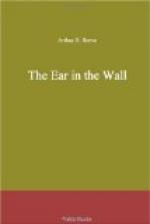“Perhaps,” I acquiesced weakly, as we went out.
Instead of turning in the direction of Carton’s immediately, Kennedy walked across the campus toward the Chemistry Building. At the laboratory we loaded ourselves with a large and heavy oblong case containing a camera and a tripod.
The Cartons lived in an old section of the city which still retained something of its aristocratic air, having been passed by, as it were, like an eddy in the stream of business that swirled uptown, engulfing everything.
It was an old four-story brownstone house which had been occupied by his father and grandfather before him, and now was the home of Carton, his mother, and his sister.
“I’m glad to see you,” Carton met us at the door. “This isn’t quite as classy a robbery as Langhorne’s—but it’s just as mysterious. Must have happened while the family were at dinner. That’s why I said it was a robbery by a sneak thief.”
He was leading the way to his study, which was in an extension of the house, in the rear.
“I hope you’ve left things as they were,” ventured Craig.
“I did,” assured Carton. “I know your penchant for such things and almost the first thought I had was that you’d prefer it that way. So I shut the door and sent William after you. By the way, what have you done with him?”
“Nothing,” returned Craig. “Isn’t he back yet?”
“No—oh, well I don’t need him right away.”
“And nothing was taken except some old photographs?” asked Craig, looking intently at Carton’s face.
“That is all I can find missing,” he returned frankly.
Kennedy’s examination of the looted study was minute, taking in the window through which the thief had apparently entered, the cabinet he had forced, and the situation in general. Finally he set up his camera with most particular care and took several flashlight pictures of the window, the cabinet, the doors— including the study—from every angle. Outside he examined the extension and back of the house carefully, noting possible ways of getting from the side street across the fences into the Carton yard.
With Carton we returned to Craig’s splendidly equipped photographic studio and while Carton and I made the best of our time by discussing various phases of the case, Kennedy employed the interval in developing his plates.
He had ten or a dozen prints, all of exactly the same size, mounted on stiff cardboard in a space with scales and figures on all four margins. Carton and I puzzled over them.
“Those are metric photographs, such as Bertillon of Paris used to take,” Craig explained. “By means of the scales and tables and other methods that have been worked out, we can determine from those pictures distances and many other things almost as well as if we were on the spot ourselves. Bertillon cleared up many crimes with this help, such as the mystery of the shooting in the Hotel Quai d’Orsay and other cases. The metric photograph, I believe, will in time rank with other devices in the study of crime.”




